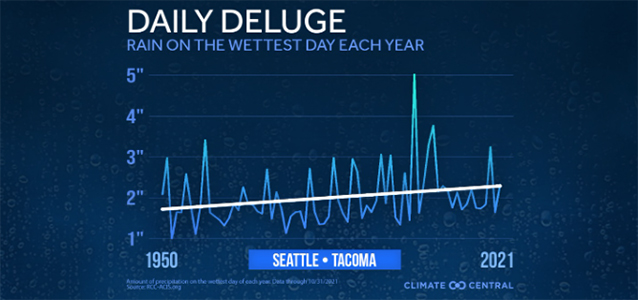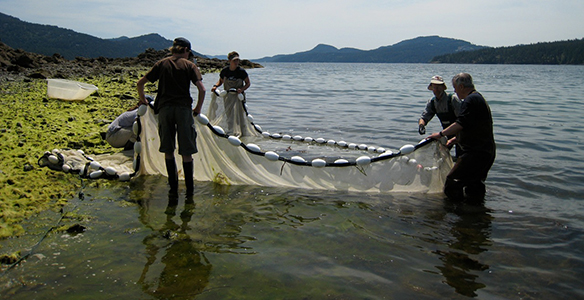||| CLIMATE EYES by STEVE BERNHEIM, theORCASONIAN REPORTER |||
In the Pacific Northwest, we’ve survived the Heat Dome but now less than five months later the bridge at Doe Bay is washed out.

While each of us decides what to do or not about the climate emergency, local authorities have been paying attention:
- County Council: At its November 9 meeting, the County Council set November 30 at 9:15 a.m. as the date for the public hearing to approve the 2023 county budget for the next two years which includes the goals and projects for the Environmental Stewardship department charged with protecting and restoring our island environment within a changing climate.
- Listed in the budget among the County’s climate accomplishments is the county’s Climate Action Progress Report according to which the county is improving energy efficiency in county buildings by changing HVAC systems, in transportation with telecommuting, in purchasing through greater awareness of alternatives, and elsewhere. The report does not say by how much the County reduced its overall energy consumption or carbon emissions or what share of county-wide necessary reductions
have been achieved, or what are the County’s goals for reduction, or by how much its emissions may have increased in other sectors. - Listed in the budget among the County’s climate action goals for the next two years are implementing a climate action plan and a sustainable tourism plan, neither of which have yet been written, though there is a proposed schedule for adopting the sustainable tourism plan.
The recent COP26 conference on international emissions limits adopted a declaration on tourism, part of which reads:
We declare our shared commitment to unite all stakeholders in transforming tourism to deliver effective climate action. We support the global commitment to halve emissions by 2030 and reach Net Zero as soon as possible before 2050. We will consistently align our actions with the latest scientific recommendations, so as to ensure our approach remains consistent with a rise of no more than 1.5°C above pre-industrial levels by 2100.
The COP26 signatories also agreed to develop tourism climate action plans within one year. Port Moody in BC adopted a climate plan last year. Send any email to Cindy Wolf, the Orcas Island representative to the County Council, about this budget’s climate goals. (There is at least one typographical error: page 2 of the current draft includes the county’s former “vision” statement instead of the current vision statement, adopted in 2018.)
School Board: At their October 28 meeting, Orcas Island School Board members learned that replacement of a petroleum-fueled diesel school bus with an electric powered vehicle must wait due to delays in shipping the charging station.
Planning Board: County staff have served the County Planning Board with more suggestions for additional climate comments in the County’s draft comprehensive plan meant to facilitate transition to the County’s vision on the climate emergency, which is:
Our community sets an example with its response to climate change. We prepare to address the negative effects in advance before they become crises. Our community encourages voluntary efforts and enacts incentives and regulations if necessary to reduce our carbon footprint.
The Board at its October 8 meeting focused attention on the draft plan’s introduction summarizing the climate matters addressed throughout the rest of the draft plan. Because San Juan County does not have a Climate Action Plan, or a separate section of its comprehensive plan addressing the climate emergency, proposed draft climate-related provisions are interspersed throughout the draft plan in existing sections as needed, for example:
- Proposed land use policies encourage development patterns that decreases reliance on fossil fuel dependent transportation.
- Draft housing policies incentivize practices that decrease fossil fuel reliance.
- Draft transportation policies support electric ferries, non-motorized transportation options and Complete Streets principles.
- Proposed Utilities policies support locally produced renewable energy and the electricity infrastructure needed to electrify transportation
- Draft Economic Development policies support transportation electrification, encouraging individuals and businesses to reduce fossil fuel consumption, and transition toward electric energy from local providers as an economically favorable alternative.
The staff proposes strategies to address sea level rise, fresh water supplies, extreme weather, and reducing fossil fuels and GHG emissions throughout the draft plan, though numerical goals for county emissions reductions are not proposed.
In other action, in March 2021 the Planning Commission unanimously agreed to establish two or three town hall meetings to hear public input on climate change and to put off further drafts of the climate change-related provisions in the comprehensive plan until after those meetings took place.
Orcas Power and Light Co-operative: OPALCO’s board was warned of brownouts during major storms if in the future members’ underestimated increasing needs for electricity from replacing gasoline engines and propane heat outstrip overestimated available future renewable supplies: OPALCO’s general manager on October 21 said:
I think that the way that we’re going — we’re looking at some of the capacity decreases going on in our region and then you look at the growth projections that are going on it doesn’t make sense, the math doesn’t add up and we know that demand is going to double by 2050 but our capacity or our supply is shrinking and that’s real — it's the right thing to do for rapid decarbonization, we need to go down that road but we also need to be very strategic about it so we don’t leave ourselves short and there’s a lot of different moving parts to this and it’s very complex and if you look around it makes sense — I mean if you look at the transformation for heating and transportation, it’s occurring right now to electrify those, those are gigantic loads of electricity which is wonderful — we get rid of the carbon out of the industry and then we actually supply them with energy to make that happen but we also need to make sure that we have the reliable energy in order to meet that and that’s becoming very very precarious.
Without county government’s leadership, local residents do what they want to do. As with the COVID emergency, without common goals and methods, the consequences could be unpleasant.
Tasks for leaders might include:
- measure and disclose San Juan County’s harmful polluting emissions using transparent and verifiable criteria;
- set and announce reduction targets in all emissions sectors;
- prioritize biodiversity and a secure, local food and water supply;
- collaborate with all neighbors on a common plan; and
- raise, shift, and allocate the money needed.









Thank-you for tracking our county responses to the Climate Emergency, Steve!
I agree with your conclusions:
Without county government’s leadership, local residents do what they want to do. As with the COVID emergency, without common goals and methods, the consequences could be unpleasant.
Your suggestions are excellent:
Tasks for leaders might include:
Measure and disclose San Juan County’s harmful polluting emissions using transparent and verifiable criteria;
Set and announce reduction targets in all emissions sectors;
Prioritize biodiversity and a secure, local food and water supply;
Collaborate with all neighbors on a common plan; and
Raise, shift, and allocate the money needed.
Steve,
You inspired me to read the 484 page long San Juan County Preliminary Budget Book for 2022-2023.
Our County Council did form a new department in 2021, the Environmental Stewardship Department.
This seems encouraging, but many of the positions are not funded for 2022 – 2023.
(For funding details: see pages 384 through 393 of the 484-page long Preliminary Budget Book.)
https://www.sanjuanco.com/DocumentCenter/View/24580/2022-2023-Preliminary-Budget-Book
The Director of the new department is Kendra Smith.
Their Mission
“Environmental Stewardship implements projects and programs in partnership with others, to protect and restore our Island environment and culture, while building resiliency within a changing climate.”
What They Do
“The Department delivers a diverse array of programs and projects supporting the preservation of our Island environment and community. The five focal areas of work include: Clean Water, Solid Waste, Marine Environment, Climate and Sustainability, and Cultural Resources.”
Department Staff: Frances Robertson, Kendra Smith, Krista Davis, Sam Whitridge
Goals:
• Develop mutually supportive projects involving Coast Salish tribes Climate and Sustainability
• Develop and secure support of a strategy of managed retreat of critical infrastructure from vulnerable shorelines
• Complete the Sustainable Tourism Management Plan
• Secure funding and begin implementation of a Climate Action Plan
Organizational Chart page 186:
Director (1 FTE)
Admin. Team (2 FTE) Note: NOT FUNDED 2022-2023
Solid Waste (1 FTE) Note: NOT FUNDED 2022-2023
Climate & Sustainability (0.8 to 1 FTE) Note: NOT FUNDED 2022-2023
Clean Water:
Surface Water: (1 FTE)
Storm water (1 FTE) Note: NOT FUNDED 2022-2023
Ground water (0.5 FTE)
Environmental Inspection (1 FTE) Note: NOT FUNDED 2022-2023
Marine Environment
MRC/Northwest Straits (0.5 FTE)
Marine Infrastructure (0.5 FTE)
Salmon Recovery (0.8 FTE)
Local Integrating Org (0.8 FTE) Note: NOT FUNDED 2022-2023
Derelict Vessels (0.2 FTE) Note: NOT FUNDED 2022-2023